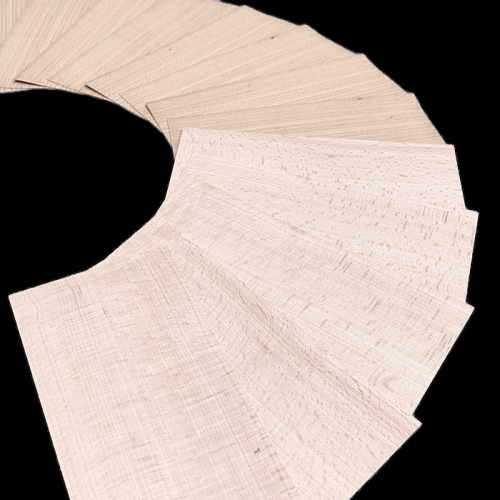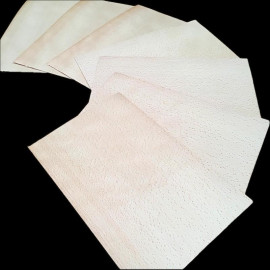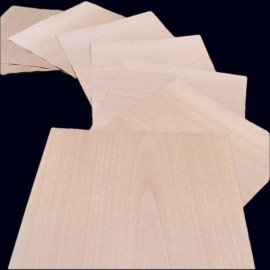- New

Natural Beech Narrow-width Small-size Veneers
Natural Beech Narrow-width Small-size Veneers
Genuine wood sliced-veneer sheets.
Selected single veneers, no sequence.
Fix length of 30 cm long.
Width: From 10 to 14 cm, depending on availability.
Thickness: 0.6 mm.
Sold by the sheet.
Natural Beech Narrow-width Small-size Veneers
Genuine wood sliced-veneer sheets.
Selected single veneers, no sequence.
Dimensions:
Fix length of 30 cm long.
Width: From 10 to 14 cm, depending on availability.
Thickness: 0.6 mm.
Sold by the sheet.
Measurement scaling:
The width is rounded to the covered centimeter, for example, 15.8 cm, giving 15 cm.
Photos:
To keep the cost of these products as cheap as possible and contrary to other veneers on this website, the pictures of small-size veneers do not represent the available stock.
What is Beech wood?
Common names:
Beech, Natural Beech, Steamed Beech, European Beech.
Botanical name:
Fagus sylvatica
Origin:
If the oak is the king of our forests, the beech is the prince. It is the second most common species after the oak in our French forests.
Beech is present throughout the northern hemisphere, from North America to Japan, but the largest population is found in Europe.
The largest beech forest in Europe is located in Germany, in the Black Forest.
Mythology and history:
Beech has an important place in European mythology and history. It was dedicated to Zeus among the Greeks and symbolized strength and power. In the Celtic tradition, it was associated with the tree of life and wisdom.
Beech has also played an important role in human history. Its wood was used to make tools, weapons, and furniture as early as the Neolithic period.
Properties:
Beech is a hardwood, slightly heavier than oak, with an average density of 730 kg/m3 (compared to 670 kg/m3 for oak).
It is an ideal wood for indoor furniture, but it is strongly discouraged for outdoor use.
Indeed, beech is a wood that "moves" according to hygroscopic variations and is not stable enough for exterior carpentry.
Remark:
Beech is a wood that takes stains well, which allows a wide range of finishes to be applied.
It is easy to use, and thanks to its firm texture and short grain, it can be cut, sculpted, and turned easily.
Aesthetics:
Beech has a relatively uniform natural color, rather creamy white with slight pinkish variations. However, it is usually steamed by cooking in steam or boiling water, which evens out its color to a light pinkish-pale. Once a finish is applied, even colorless, the pinkish color becomes light camel.
Traditional uses:
In addition to chairs and furniture, beech wood was used in the Middle Ages to make plates, bowls, bows, and arrows.
Contemporary uses:
Beech wood is used to manufacture furniture, flooring, stairs, chairs, high-end plywood (including seat shells and bed slats), and decorative veneers.
Beech is also used for the production of charcoal and firewood.
What are wood veneers?
Veneers are thin sheets of wood obtained by slicing or peeling.
Their surface has the appearance of planed wood without any finish or treatment. They are neither glued nor backed with any other material. This means that both faces of the sheets can be used.
Veneers are mainly used to cover less aesthetic substrates such as plywood or particleboard to make furniture or wall panels.
Wood veneers are also used to create decorative objects such as lamps, jewelry, bookmarks, and more.
By assembling several sheets of veneer on top of each other, it is possible to manufacture objects requiring high mechanical resistance, such as skis, bicycle frames, or musical instruments.
The applications of veneer are as varied as they are multiple.
Since veneers are genuine wood, all wood finishing products, whether varnish, stain, or oil, are suitable. The choice of finish will depend on your personal preferences and the final use of the object.
The veneer offered here is a sliced sheet of uniform thickness, but the thickness might differ from one species to another. The standard thickness is around 0.6 mm.
Although the edges of the veneers have been cut roughly straight, the cut is not perfectly parallel. Some veneers may retain the natural taper of the tree, being slightly wider at the foot than at the top.
Some veneers may have a trace of a waney edge (an edge following the tree's natural shape) on the sides. In this case, the dimensions indicated correspond to the minimum width of the veneer, as specified in the "Dimensions" paragraph.
How to use veneers?
How to cut the veneers?
Veneers can be easily cut with a utility knife.
For straight cuts, the best results are obtained with a veneer saw.
Use a fretsaw, scalpel, or veneer knife for curved cuts.
Always allow for a slightly larger veneer sheet than your intended surface. This will allow you to adjust the size after gluing for a clean finish.
A flush trimmer can also be used to trim the veneer after gluing.
When cutting with a utility knife or veneer knife, it is best to cut with the grain of the wood. To check this, run your finger along the edge of the sheet. The direction that feels smoothest is the ideal direction for cutting.
What is veneer splicing?
As the veneers have the width that nature gave us, you might need to cover an area wider than the veneers available.
Therefore, you need to splice the veneers by gluing or fixing them side by side with tape to obtain the desired width.
Trim the veneer's edges with a straight and smooth cut to realize good jointing.
Stick the veneers with tape (the blue one is a good choice.)
Usually, the veneers are spliced side by side, but to obtain a longer length, they can be done foot by foot.
The splicing must be done before gluing the veneers on the substrate.
What Glue to Use for Veneering?
Several types of gluing are possible.
Vinylic glue (PVA or PVB) is well adapted to porous substrates such as plywood, particle board, or MDF. The veneers must be pressed with clamps over the entire surface at once.
Note: A technique using vinylic glue and an iron can also be used to glue veneers, but we strongly recommend choosing this technique only if other gluing solutions are impossible.
- Neoprene glue is applied to all surfaces, especially non-porous surfaces, using two coats of glue and marouflage.
- Animal glue, such as hide, sinew, or bone glue, are pellets that must be cooked in a double boiler and used hot.
How to Sand Veneers?
Veneers and all our products are genuine wood and can be sanded according to thickness.
Please do not use a belt sander, regardless of the thickness of the veneer, as this could pierce it.
With a 0.6 mm veneer, lightly sand with 120 grit and then finish with 180 or 240 grit. With an orbital sander, 180 grit is already sufficient for most applications.
How to Finish a Veneer Realization?
All finishing products generally used for wood are suitable for finishing our products. For example, you can use a varnish, wax, paint, or oil.
However, ensure that the product you want to use is compatible with the final use of your creation.
More information:
Please look at our TUTORIALS; you might find some valuable tips.
Please contact us by email or phone for any additional information.
Data sheet
- Species
- Beech
- Thickness group
- Standard
- Width group
- Narrow width
You might also like
 English
English






